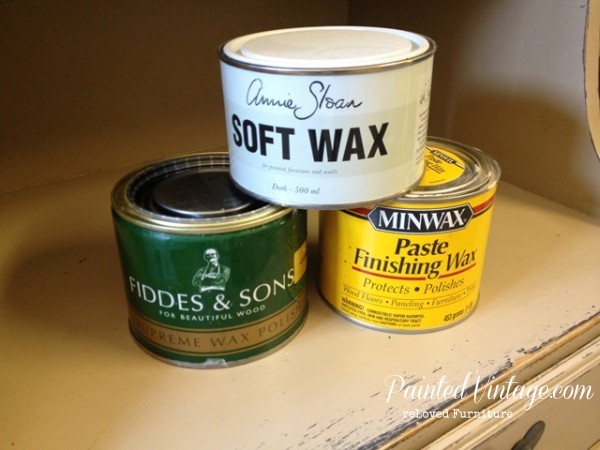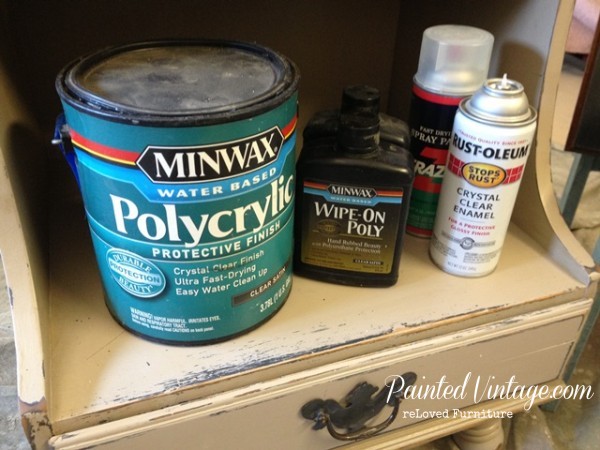To wax or not to wax?
Ah… The age old question: “To wax or not to wax over chalk paint?”
OK, so maybe it isn’t the question that’s been around for as long as chalk paint itself, but it is definitely a dilemma I’ve been facing more and more…
Nothing compares to the soft luster and rich glow of a freshly waxed piece of reLoved furniture!! However, applying wax over chalk paint is the most challenging, labor intensive and time consuming aspect of painting furniture with chalk and chalk-style paint.
Granted, not all waxes are created equal. Some waxes are downright difficult to work with and even require you to take a special class on proper application techniques.
Then there’s the durability issue.
Yes, I have an issue… Wax only offers minimal protection and wax is NOT permanent. Nor is it even semi-permanent. In fact, if it was a hair dye, it would be temporary!!
You see, wax wears off over time with use, leaving your beautiful chalk painted furniture all porous and exposed; a magnet for chocolaty little fingers and cheese puff smudges!
In order to maintain continued protection, wax needs to be reapplied every few months!
But wax isn’t THE ONLY option!
Why not go with a water-based polyurethane sealer, such as Varethane or Polycrylic over chalk paint?
These products are an excellent alternative, and offer far superior protection than a wax. A few coats of polycrylic will last YEARS beyond a few coats of wax, and can be much easier to work with.
Plus, polycrylics are more chemical resistant and are not heat sensitive like wax.
And unlike wax, if you ever chose to repaint your furniture, the polycrylic does not need to be 100% completely removed.
Don’t get me wrong, polycrylics are not without drawbacks.
Although they can have a yellowing effect over white and light colors, I personally have had good success with Varethane staying clear. Some waxes will yellow also, so that can still be an issue if you went that route. (I have also used clear spray-on sealers for smaller projects, with no issues what-so-ever!)
With the ease of application, I am finding water-based polyurethanes to be my go-to finish of choice over chalk painted furniture.
And if you are looking for a good alternative to do-it-yourself chalk-style paint, read my post on an Not So DIY Chalk Paint Recipe.
I’d love to hear your feedback! What is your sealer of choice over chalk paint and chalk-style paint on your reLoved furniture, and what, if any, challenges do you face?
**UPDATE**
Still have questions?? I posted an update with answers to all the most commonly asked questions I’ve received.
You can read it here: “Wax or Polycrylic Over Chalk Paint?”








I found Varathane Diamond Wood Finish at my building store – is that what I am supposed to get? Also do you have to sand between coats with the Varathane? Or just the polycrylic?
Yes! That’s it! I usually sand lightly between coats.
What about something to use as a final coat for a bottle( glass)? I want to maintain the chalk appearance but still want the surface protected.
Hi Sherri,
I just finished chalk painting my son’s dresser black, which poly do you think would be best for a first timer?
Thanks!
Hi Amber,
I would definitely try Rust-Oleum’s Varathane!! Its easy to apply, dries quickly to a durable finish and I have never had any issues with yellowing or ambering.
Dear Sherri,
Does the Varathane by Rust Oleum come in something other then the Gallon size? I have my husband asking for it at Loewes and it is in the gallon only. I have Minwax polycrylic spray at home but do not want to use it for fear of the Yellowing of my,” Ce Ce Caldwell ” Chalk painted tables in the Young Kansas Wheat color. It’s really pretty so I want no yellowing to interfere with my hard work. Please help. Thank you Lisa
Yes, I purchase from my local Lowes and they also have the quart and half pint sizes.
Hello, I’ve just done a bedside cabinet with homemade chalk paint and am very pleased with it. I was trying to decide how to finish it, when I stumbled across this thread. I have some satin finish yatch varnish and some beeswax in the house. I’ve no idea if the varnish is water based, but I suspect not. Why does it have to be water based please?
The water-based finishes are usually non-yellowing. Most Spar (Marine) Varnishes will amber.
Hi There, i recently painted a few items in my home with a homemade chalk paint…behr flat latex with unsanded grout. I do want to put a glaze, or something, to antique it a little more. Is it best to do a darker wax and then cover the whole area with the clear poly? Do i need to do any sanding between coats?
Hi Abby,
I personally like glazing followed by a clear polyurethane. I sand lightly between coats with a fine sandpaper.
But you can also use a darker wax. If you decide to go this route, use a clear wax prior to the dark wax, so the dark wax does not stain the chalk paint.
Hi! I am new to the Annie Sloan phenomenon and I was wondering… if I use polycrylic on top of the Annie Sloan paint instead of wax, do I need to sand it at all?
Hi Roxy, I usually sand lightly between clear coats. But if the finish feels smooth enough, and you are happy with it, you don’t need to do any extra sanding.
What is the difference between chalk paint and latex paint for painting furniture.
Hi Sherri,
I’m doing research about available products to paint over my early 1990′s kitchen cupboards. You mention above that you’re not a fan of Chalk-Painted Cabinets. Can you please explain why. My cupboards are your basic oak with a poly applied over it. I’m looking to paint them a warm cream or white and plan to do the work myself. I’ve read to get the most professional look possible, I should spray the doors rather than brush them. I’ve reads lots of articles on latex, oil-based and chalk paint. Thanks for your insight.
Hi Sherri –
Thanks so much for the great info. We’re painting our kitchen cabinets with ASCP and wanted to go with the poly. I am concerned about the yellowing effect and wanted to see if you’d confirm I’ve got the right product that you have had good success with. The only Varathane product I can find at Lowes is the Varathane Gloss Porch and Floor Clear Water-Base Paint. Am I on the same page as you with this product?
Thanks so much!!!
Brett
WHEW! I just bought an EXPENSIVE little test pot of Annie Sloan to see what the big deal was, and was really NOT in the mood to buy an EXPENSIVE thing of wax. I’ve got the Minwax finish already at the house – yay! Thanks for the reassurance that it might be a great low-cost alternative!
Ali
Hello .. I have a question on applying the Polycrylic, if I am using a glaze over my chalk paint ,can that be done straight over the paint or do I have to poly it first?
Personally, I would apply a coat of poly, and then glaze over the poly.
I just finished a dresser with chalk paint. I usually do clear wax and then dark wax. I want to try to do a dark glaze instead of dark wax this time. What order should I do now? Should I poly, glaze, and then poly again? Can I go straight to glazing and then poly, or can I only glaze and be done? Thanks!
I find I have better results using a poly before the glaze, and then again after. Otherwise I don’t like the look of the glaze staining the porous chalk paint.
I just learned how to use dark wax for an antique look. I’m going to be trying to out on my new kitchen buffet I found but I want to make sure it’s SEALED. I have a toddler that loves to touch. I was curious if I could either poly my work and then use dark wax or if I can dark wax and then poly. If I dark wax and then poly will it still be the same affect or will the poly not hold because of the wax?
I was going to ask the same question! I have a piece that I want to chalk paint, then use the dark wax for details but definitely poly over the whole thing. Would that work Sherri?
You cannot apply the poly over the wax. If you decide to use a wax, it must be your last step. You could however, use a glaze and poly over the glaze.
Hello,
I have just installed a plywood plank floor in the re-made attic space in my house. I am white-washing it white (just paint and water applied with a rag). I chose a paint that was pure white so it would not yellow but when applying the poly sealer, I noticed that the test patch yellowed some. The Artisian Enhancement top coat mentioned in your thread is not available in my town. I wonder if you can recommend another (more common?) non-yellowing water based top-coat (preferably one that could be painted over if need be, like the AE top coat)? Thank you for all of the information you broker here.
There is a waterbased product called Varethene, you can purchase from lowes. I have had excellent results with it not yellowing!
Question.. I have painted my cabinets with annie Sloan old white… Sealed them with polycrylic clear today… As I watch them dry they are having a crackled look they did NOT have before…. Can I just paint over with latex and seal them and be done…. I don’t see me reprinting with more annie Sloan and then trying to reseal them again hoping they want crack?? Help?!?